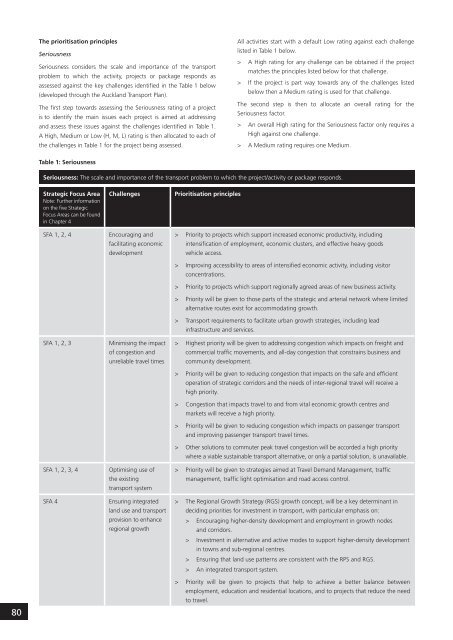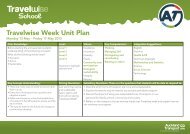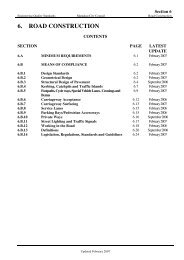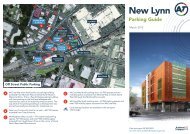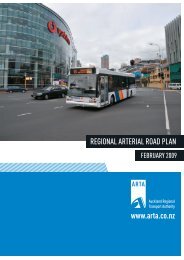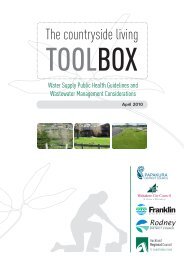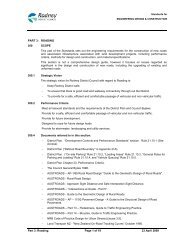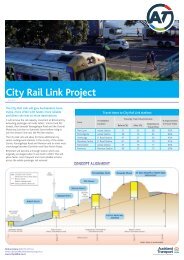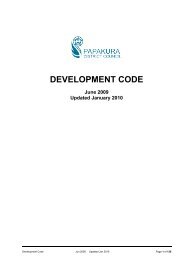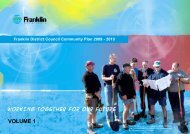Regional Land Transport Programme 2009 - 2010 (2MB) - Auckland ...
Regional Land Transport Programme 2009 - 2010 (2MB) - Auckland ...
Regional Land Transport Programme 2009 - 2010 (2MB) - Auckland ...
You also want an ePaper? Increase the reach of your titles
YUMPU automatically turns print PDFs into web optimized ePapers that Google loves.
The prioritisation principles<br />
Seriousness<br />
Seriousness considers the scale and importance of the transport<br />
problem to which the activity, projects or package responds as<br />
assessed against the key challenges identified in the Table 1 below<br />
(developed through the <strong>Auckland</strong> <strong>Transport</strong> Plan).<br />
The first step towards assessing the Seriousness rating of a project<br />
is to identify the main issues each project is aimed at addressing<br />
and assess these issues against the challenges identified in Table 1.<br />
A High, Medium or Low (H, M, L) rating is then allocated to each of<br />
the challenges in Table 1 for the project being assessed.<br />
All activities start with a default Low rating against each challenge<br />
listed in Table 1 below.<br />
> A High rating for any challenge can be obtained if the project<br />
matches the principles listed below for that challenge.<br />
> If the project is part way towards any of the challenges listed<br />
below then a Medium rating is used for that challenge.<br />
The second step is then to allocate an overall rating for the<br />
Seriousness factor.<br />
> An overall High rating for the Seriousness factor only requires a<br />
High against one challenge.<br />
> A Medium rating requires one Medium.<br />
Table 1: Seriousness<br />
Seriousness: The scale and importance of the transport problem to which the project/activity or package responds.<br />
Strategic Focus Area<br />
Note: Further information<br />
on the five Strategic<br />
Focus Areas can be found<br />
in Chapter 4<br />
Challenges<br />
Prioritisation principles<br />
SFA 1, 2, 4<br />
Encouraging and<br />
facilitating economic<br />
development<br />
><br />
Priority to projects which support increased economic productivity, including<br />
intensification of employment, economic clusters, and effective heavy goods<br />
vehicle access.<br />
><br />
Improving accessibility to areas of intensified economic activity, including visitor<br />
concentrations.<br />
><br />
Priority to projects which support regionally agreed areas of new business activity.<br />
><br />
Priority will be given to those parts of the strategic and arterial network where limited<br />
alternative routes exist for accommodating growth.<br />
><br />
<strong>Transport</strong> requirements to facilitate urban growth strategies, including lead<br />
infrastructure and services.<br />
SFA 1, 2, 3<br />
Minimising the impact<br />
of congestion and<br />
unreliable travel times<br />
><br />
Highest priority will be given to addressing congestion which impacts on freight and<br />
commercial traffic movements, and all-day congestion that constrains business and<br />
community development.<br />
><br />
Priority will be given to reducing congestion that impacts on the safe and efficient<br />
operation of strategic corridors and the needs of inter-regional travel will receive a<br />
high priority.<br />
><br />
Congestion that impacts travel to and from vital economic growth centres and<br />
markets will receive a high priority.<br />
><br />
Priority will be given to reducing congestion which impacts on passenger transport<br />
and improving passenger transport travel times.<br />
><br />
Other solutions to commuter peak travel congestion will be accorded a high priority<br />
where a viable sustainable transport alternative, or only a partial solution, is unavailable.<br />
SFA 1, 2, 3, 4<br />
Optimising use of<br />
the existing<br />
transport system<br />
><br />
Priority will be given to strategies aimed at Travel Demand Management, traffic<br />
management, traffic light optimisation and road access control.<br />
SFA 4<br />
Ensuring integrated<br />
land use and transport<br />
provision to enhance<br />
regional growth<br />
><br />
The <strong>Regional</strong> Growth Strategy (RGS) growth concept, will be a key determinant in<br />
deciding priorities for investment in transport, with particular emphasis on:<br />
> Encouraging higher-density development and employment in growth nodes<br />
and corridors.<br />
><br />
Investment in alternative and active modes to support higher-density development<br />
in towns and sub-regional centres.<br />
><br />
Ensuring that land use patterns are consistent with the RPS and RGS.<br />
><br />
An integrated transport system.<br />
80<br />
><br />
Priority will be given to projects that help to achieve a better balance between<br />
employment, education and residential locations, and to projects that reduce the need<br />
to travel.


